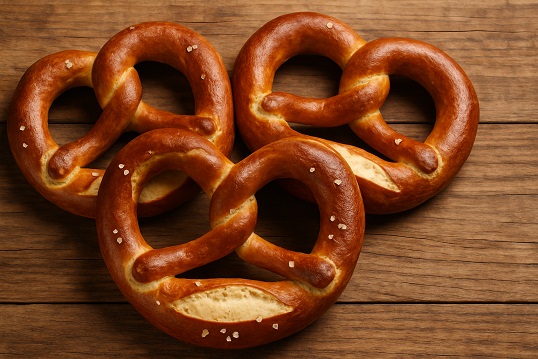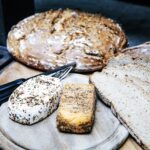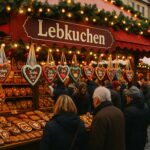
A Twist That Tells a Story
With its golden crust, chewy interior, and unmistakable knotted shape, the German pretzel (Brezel) is one of the most iconic baked goods in the world. But behind its satisfying crunch lies a story that stretches back centuries – through medieval monasteries, royal banquets, and bustling beer halls.
In Germany, the pretzel is not just a snack. It’s a symbol of faith, craftsmanship, and cultural pride. It has been used as a religious emblem, a sign of good luck, a festive food, and even a form of currency. Whether you’re biting into a fresh Laugenbrezel in Bavaria or admiring a baker’s sign in Swabia, the pretzel is everywhere – and it has a story to tell.
In this article, we explore the history of the German pretzel, how it evolved over time, and why this humble knot of dough still matters in modern Germany.
Ancient Origins and Sacred Shapes of Pretzel

The exact origin of the pretzel is difficult to trace, but one widely accepted theory ties it to early medieval monastic life. By the 6th or 7th century, monks in southern France or northern Italy are believed to have developed a looped bread that symbolized arms crossed in prayer. They called it pretiola (“little reward”) and gave it to children for learning their prayers.
As Christianity spread through German-speaking regions, so did the pretzel. By the 12th century, it had become a popular Lenten food, since it was made with simple, fasting-approved ingredients: flour, water, and salt. Its religious associations only deepened over time, and the pretzel began appearing in religious manuscripts and church art.
The pretzel’s three holes were said to represent the Holy Trinity, and its shape a symbol of devotion and blessing. In this context, the pretzel was not only food – it was a symbol of spiritual nourishment.
The Rise of the German Brezel
In Germany, the pretzel (Brezel in modern High German) found its spiritual home. By the 15th century, it was deeply embedded in southern German culture, especially in Bavaria, Swabia, and Franconia. Guilds of bakers took pride in perfecting its shape and crust, and pretzels became a sign of bakery excellence – literally. Many bakeries still feature the pretzel as their official emblem.
One key innovation happened around the early 19th century in Munich: a baker allegedly dropped dough into a lye solution by accident. Instead of discarding it, he baked it – and discovered a beautifully bronzed crust with a distinct flavor. Thus was born the Laugenbrezel (lye pretzel), now the dominant style across southern Germany.
Today’s German pretzels are typically:
- Deep brown on the outside, thanks to the lye wash
- Chewy and soft on the inside
- Knotted in a signature twist, with plump “bellies” and thin arms
- Sprinkled with coarse salt, or sometimes pumpkin seeds, cheese, or sesame
More Than a Snack: The Pretzel’s Cultural Roles
A Symbol of Prosperity
In the Middle Ages, pretzels were often hung on Christmas trees or given as New Year’s gifts, symbolizing good luck and prosperity. In some regions, children still wake up on January 1st to a breakfast of sweet pretzels, wishing each other a good year.
A Staple of Beer Culture
No Oktoberfest is complete without a giant pretzel the size of your head, served alongside a liter of beer and a slab of butter (Obatzda optional). In Bavarian beer gardens, the pretzel isn’t just a snack – it’s a social tradition, passed around and shared at long communal tables.
A Sign of Artisan Skill
In Swabia, a true baker is judged by their ability to hand-twist a pretzel in seconds flat. The dough must be stretched and folded just right to create the perfect plump belly and crisp arms. It’s a dance of speed and muscle memory – and a respected skill taught through generations.
Regional Variations: One Twist, Many Tastes
While the basic concept remains the same, Germany boasts dozens of regional pretzel varieties, each with its own flair.
- Bavarian Brezel: Thick, soft, and often served warm with butter or white sausage (Weißwurst).
- Swabian Brezel: Slightly thinner, with less puff and more crunch. A favorite in Baden-Württemberg.
- Pfälzer Brezel: From the Palatinate region, often sweeter and eaten with jam.
- Silserli (Swiss-style): Found near the German border in Switzerland, often as rolls with the same lye treatment.
- Brezelknödel: A creative use of day-old pretzels – turned into delicious dumplings (Knödel).
And yes, Germany even has pretzel sandwiches, like the Laugenstange, which is a long pretzel roll filled with cheese, ham, or salami – popular at bakeries across the country.
Looking to bake your own? Explore our German Recipes collection for authentic breads, cakes, and savory classics.
Pretzels in Modern Germany (and Beyond)
Pretzels are no longer just a traditional food – they’re a national symbol. You’ll find them in bakery logos, beer labels, children’s books, and souvenir shops. They’re both ancient and trendy, appearing in modern forms like pretzel buns for burgers, chocolate-dipped snack sticks, and even vegan varieties.
Germany remains the global capital of pretzels, but the rest of the world has caught on. American soft pretzels, especially in Pennsylvania Dutch communities, owe their origin to German immigrants. In recent years, German-style bakeries around the world have revived interest in the traditional Brezel, complete with lye treatment and handmade twisting.
Practical Tips: How to Enjoy a German Pretzel
- Eat it fresh: Most German pretzels are best enjoyed the same day they’re baked. Try your hand at the real thing with our authentic Pretzels (Brezn) Recipe.
- Bake your own: Whether you like them classic or creative, our Soft Homemade Pretzels are a perfect starting point.
- Make it a snack platter: Serve pretzels with tangy dips like the crowd-pleasing Honey Mustard Dipping Sauce.
- Explore more baked goods: If pretzels have sparked your interest, browse our full collection of German Baking Recipes – from breads to cakes and beyond.
A Twist of Tradition
The history of the German pretzel is one of faith, food, and fascinating evolution. From its sacred beginnings to its modern-day snack status, the pretzel has remained a delicious symbol of German identity. Whether enjoyed at a beer hall, a bakery, or your own kitchen table, it’s more than just bread – it’s a bite of history, hand-twisted into shape.
Craving more German baked goodness? Bake your way through tradition with our Pretzel Recipes and explore Authentic German Baking to get started.
Prost – and don’t forget the mustard!







